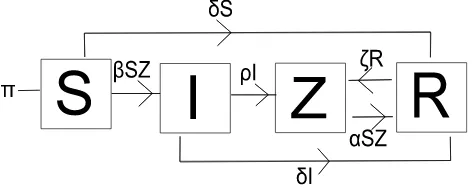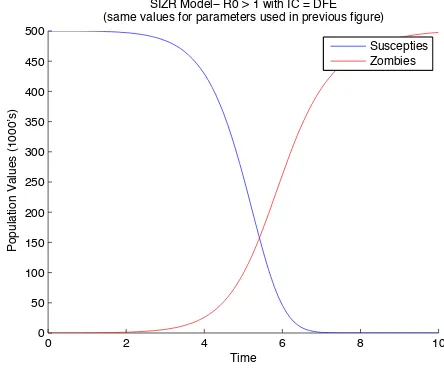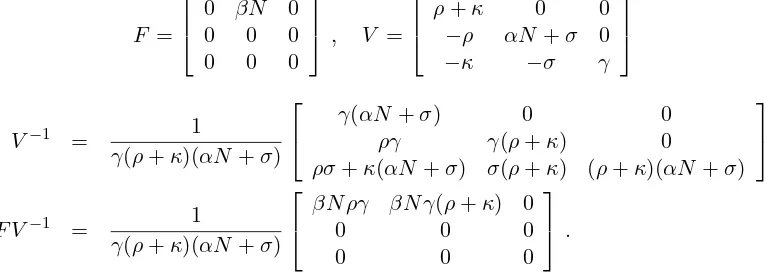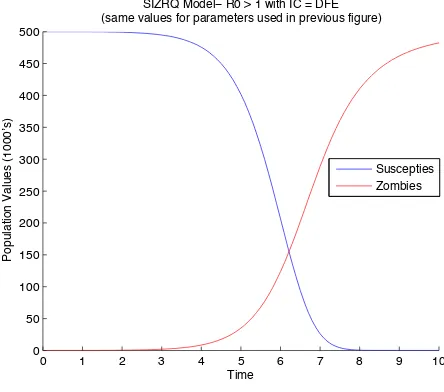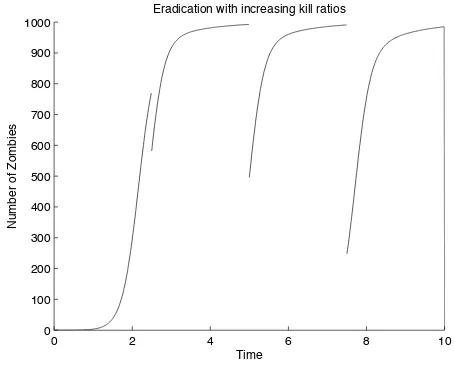Editors: J.M. Tchuenche and C. Chiyaka, pp. 133-150c 2009 Nova Science Publishers, Inc.
Chapter 4
WHEN
ZOMBIES
ATTACK!: MATHEMATICAL
M
ODELLING OF AN
O
UTBREAK OF
Z
OMBIE
I
NFECTION
Philip Munz1∗, Ioan Hudea1†, Joe Imad2‡, Robert J. Smith?3§
1
School of Mathematics and Statistics, Carleton University, 1125 Colonel By Drive, Ottawa, ON K1S 5B6, Canada 2
Department of Mathematics, The University of Ottawa, 585 King Edward Ave, Ottawa ON K1N 6N5, Canada 2
Department of Mathematics and Faculty of Medicine, The University of Ottawa, 585 King Edward Ave, Ottawa ON K1N 6N5, Canada
Abstract
Zombies are a popular figure in pop culture/entertainment and they are usually portrayed as being brought about through an outbreak or epidemic. Consequently, we model a zombie attack, using biological assumptions based on popular zombie movies. We introduce a basic model for zombie infection, determine equilibria and their stability, and illustrate the outcome with numerical solutions. We then refine the model to introduce a latent period of zombification, whereby humans are infected, but not infectious, before becoming undead. We then modify the model to include the effects of possible quarantine or a cure. Finally, we examine the impact of regular, impulsive reductions in the number of zombies and derive conditions under which eradication can occur. We show that only quick, aggressive attacks can stave off the doomsday scenario: the collapse of society as zombies overtake us all.
1.
Introduction
A zombie is a reanimated human corpse that feeds on living human flesh [1]. Stories about zombies originated in the Afro-Caribbean spiritual belief system of Vodou (anglicised
∗
E-mail address: [email protected] †
E-mail address: [email protected] ‡
E-mail address: [email protected] §
voodoo). These stories described people as being controlled by a powerful sorcerer. The walking dead became popular in the modern horror fiction mainly because of the success of George A. Romero’s 1968 film, Night of the Living Dead [2]. There are several possible etymologies of the word zombie. One of the possible origins isjumbie, which comes from the Carribean term for ghost. Another possible origin is the wordnzambiwhich in Kongo means ‘spirit of a dead person’. According to the Merriam-Webster dictionary, the word zombie originates from the wordzonbi, used in the Louisiana Creole or the Haitian Creole. According to the Creole culture, a zonbi represents a person who died and was then brought to life without speech or free will.
The followers of Vodou believe that a dead person can be revived by a sorcerer [3]. After being revived, the zombies remain under the control of the sorcerer because they have no will of their own. Zombi is also another name for a Voodoo snake god. It is said that the sorcerer uses a ‘zombie powder’ for the zombification. This powder contains an extremely powerful neurotoxin that temporarily paralyzes the human nervous system and it creates a state of hibernation. The main organs, such as the heart and lungs, and all of the bodily functions, operate at minimal levels during this state of hibernation. What turns these human beings into zombies is the lack of oxygen to the brain. As a result of this, they suffer from brain damage.
A popular belief in the Middle Ages was that the souls of the dead could return to earth one day and haunt the living [4]. In France, during the Middle Ages, they believed that the dead would usually awaken to avenge some sort of crime committed against them during their life. These awakened dead took the form of an emaciated corpse and they wandered around graveyards at night. The idea of the zombie also appears in several other cultures, such as China, Japan, the Pacific, India, Persia, the Arabs and the Americas.
Modern zombies (the ones illustrated in books, films and games [1, 5]) are very dif-ferent from the voodoo and the folklore zombies. Modern zombies follow a standard, as set in the movie Night of the Living Dead [2]. The ghouls are portrayed as being mindless monsters who do not feel pain and who have an immense appetite for human flesh. Their aim is to kill, eat or infect people. The ‘undead’ move in small, irregular steps, and show signs of physical decomposition such as rotting flesh, discoloured eyes and open wounds. Modern zombies are often related to an apocalypse, where civilization could collapse due to a plague of the undead. The background stories behind zombie movies, video games etc, are purposefully vague and inconsistent in explaining how the zombies came about in the first place. Some ideas include radiation (Night of the Living Dead [2]), exposure to air-borne viruses (Resident Evil [6]), mutated diseases carried by various vectors (Dead Rising [7] claimed it was from bee stings of genetically altered bees). Shaun of the Dead [8] made fun of this by not allowing the viewer to determine what actually happened.
When a susceptible individual is bitten by a zombie, it leaves an open wound. The wound created by the zombie has the zombie’s saliva in and around it. This bodily fluid mixes with the blood, thus infecting the (previously susceptible) individual.
re-make of Dawn of the Dead [10]. These ‘zombies’ can move faster, are more independent and much smarter than their classical counterparts. While we are trying to be as broad as possible in modelling zombies – especially since there are many varieties – we have decided not to consider these individuals.
2.
The Basic Model
For the basic model, we consider three basic classes:
• Susceptible (S).
• Zombie (Z).
• Removed (R).
Susceptibles can become deceased through ‘natural’ causes, i.e., non-zombie-related death (parameter δ). The removed class consists of individuals who have died, either through attack or natural causes. Humans in the removed class can resurrect and become a zombie (parameter ζ). Susceptibles can become zombies through transmission via an encounter with a zombie (transmission parameterβ). Only humans can become infected through contact with zombies, and zombies only have a craving for human flesh so we do not consider any other life forms in the model. New zombies can only come from two sources:
• The resurrected from the newly deceased (removed group).
• Susceptibles who have ‘lost’ an encounter with a zombie.
In addition, we assume the birth rate is a constant,Π. Zombies move to the removed class upon being ‘defeated’. This can be done by removing the head or destroying the brain of the zombie (parameterα). We also assume that zombies do not attack/defeat other zombies.
Thus, the basic model is given by
S′ = Π−βSZ−δS
Z′ = βSZ+ζR−αSZ
R′ = δS+αSZ−ζR .
This model is illustrated in Figure 1.
This model is slightly more complicated than the basic SIR models that usually char-acterise infectious diseases [11], because this model has two mass-action transmissions, which leads to having more than one nonlinear term in the model. Mass-action incidence specifies that an average member of the population makes contact sufficient to transmit in-fection with βN others per unit time, where N is the total population without infection. In this case, the infection is zombification. The probability that a random contact by a zombie is made with a susceptible isS/N; thus, the number of new zombies through this transmission process in unit time per zombie is:
Figure 1. The basic model.
We assume that a susceptible can avoid zombification through an altercation with a zombie by defeating the zombie during their contact, and each susceptible is capable of resisting infection (becoming a zombie) at a rate α. So, using the same idea as above with the probabilityZ/N of random contact of a susceptible with a zombie (not the probability of a zombie attacking a susceptible), the number of zombies destroyed through this process per unit time per susceptible is:
(αN)(Z/N)S = αSZ .
The ODEs satisfy
S′+Z′+R′ = Π
and hence
S+Z+R → ∞
ast→ ∞, ifΠ6= 0. ClearlyS 6→ ∞, so this results in a ‘doomsday’ scenario: an outbreak of zombies will lead to the collapse of civilisation, as large numbers of people are either zombified or dead.
If we assume that the outbreak happens over a short timescale, then we can ignore birth and background death rates. Thus, we setΠ =δ = 0.
Setting the differential equations equal to0gives
−βSZ = 0
βSZ+ζR−αSZ = 0
αSZ−ζR = 0.
From the first equation, we have eitherS = 0orZ = 0. Thus, it follows fromS = 0that we get the ‘doomsday’ equilibrium
( ¯S,Z,¯ R¯) = (0,Z,¯ 0).
These equilibrium points show that, regardless of their stability, human-zombie coexistence is impossible.
The Jacobian is then
J =
The Jacobian at the disease-free equilibrium is
J(N,0,0) =
It follows that the characteristic equation always has a root with positive real part. Hence, the disease-free equilibrium is always unstable.
Next, we have
Since all eigenvalues of the doomsday equilibrium are negative, it is asymptotically stable. It follows that, in a short outbreak, zombies will likely infect everyone.
In the following figures, the curves show the interaction between susceptibles and zom-bies over a period of time. We used Euler’s method to solve the ODE’s. While Euler’s method is not the most stable numerical solution for ODE’s, it is the easiest and least time-consuming. See Figures 2 and 3 for these results. The MATLAB code is given at the end of this chapter. Values used in Figure 3 wereα = 0.005, β = 0.0095, ζ = 0.0001and
δ= 0.0001.
3.
The Model with Latent Infection
We now revise the model to include a latent class of infected individuals. As discussed in Brooks [1], there is a period of time (approximately 24 hours) after the human susceptible gets bitten before they succumb to their wound and become a zombie.
We thus extend the basic model to include the (more ‘realistic’) possibility that a sus-ceptible individual becomes infected before succumbing to zombification. This is what is seen quite often in pop-culture representations of zombies ([2, 6, 8]).
0 1 2 3 4 5 6 7 8 9 10
Figure 2. The case of no zombies. However, this equilibrium is unstable.
• Susceptibles first move to an infected class once infected and remain there for some period of time.
• Infected individuals can still die a ‘natural’ death before becoming a zombie; other-wise, they become a zombie.
We shall refer to this as the SIZR model. The model is given by
S′ = Π−βSZ−δS
I′ = βSZ−ρI−δI
Z′ = ρI+ζR−αSZ
R′ = δS+δI+αSZ−ζR
The SIZR model is illustrated in Figure 4
As before, ifΠ 6= 0, then the infection overwhelms the population. Consequently, we shall again assume a short timescale and henceΠ = δ = 0. Thus, when we set the above equations to0, we get eitherS = 0orZ = 0from the first equation. It follows again from our basic model analysis that we get the equilibria:
Z = 0 =⇒ ( ¯S,I,¯ Z,¯ R¯) = (N,0,0,0)
S= 0 =⇒ ( ¯S,I,¯ Z,¯ R¯) = (0,0,Z,¯ 0)
Thus, coexistence between humans and zombies/infected is again not possible. In this case, the Jacobian is
0 0.5 1 1.5 2 2.5 3 3.5 4 4.5 5 0
100 200 300 400 500 600
Time
Population Values (1000’s)
Basic Model! R0 > 1 with IC = DFE
Suscepties Zombies
Figure 3. Basic model outbreak scenario. Susceptibles are quickly eradicated and zombies take over, infecting everyone.
Figure 4. The SIZR model flowchart: the basic model with latent infection.
First, we have
det(J(N,0,0,0)−λI) = det
−λ 0 −βN 0
0 −ρ−λ βN 0 0 ρ −αN −λ ζ
0 0 αN −ζ−λ
= −λdet
−ρ−λ βN 0
ρ −αN−λ ζ
0 αN −ζ−λ
= −λ
−λ3
−(ρ+ζ+αN)λ2
−(ραN +ρζ−ρβN)λ
+ρζβN].
Next, we have follows that the doomsday equilibrium is stable. Thus, even with a latent period of infection, zombies will again take over the population.
We plotted numerical results from the data again using Euler’s method for solving the ODEs in the model. The parameters are the same as in the basic model, withρ = 0.005. See Figure 5. In this case, zombies still take over, but it takes approximately twice as long.
0 2 4 6 8 10 (same values for parameters used in previous figure)
Suscepties Zombies
Figure 5. An outbreak with latent infection.
4.
The Model with Quarantine
In order to contain the outbreak, we decided to model the effects of partial quarantine of zombies. In this model, we assume that quarantined individuals are removed from the population and cannot infect new individuals while they remain quarantined. Thus, the changes to the previous model include:
• The quarantined area only contains members of the infected or zombie populations (entering at ratesκandσ, respectively).
• There is a chance some members will try to escape, but any that tried to would be killed before finding their ‘freedom’ (parameterγ).
The model equations are:
The model is illustrated in Figure 6.
Figure 6. Model flow diagram for the Quarantine model. For a short outbreak (Π =δ= 0), we have two equilibria,
( ¯S,I,¯Z,¯ R,¯ Q¯) = (N,0,0,0,0),(0,0,Z,¯ R,¯ Q¯).
In this case, in order to analyse stability, we determined the basic reproductive ratio,R0 [12] using the next-generation method [13]. The basic reproductive ratio has the property that ifR0 >1, then the outbreak will persist, whereas ifR0 <1, then the outbreak will be eradicated.
If we were to determine the Jacobian and evaluate it at the disease-free equilibrium, we would have to evaluate a nontrivial 5 by 5 system and a characteristic polynomial of degree of at least 3. With the next-generation method, we only need to consider the infective differential equationsI′, Z′ andQ′. Here,F is the matrix of new infections andV is the
matrix of transfers between compartments, evaluated at the disease-free equilibrium.
This gives us
R0 =
βN ρ
(ρ+κ)(αN+σ).
It follows that the disease-free equilibrium is only stable if R0 < 1. This can be achieved by increasingκ orσ, the rates of quarantining infected and zombified individ-uals, respectively. If the population is large, then
R0 ≈
βρ
(ρ+κ)α .
Ifβ > α(zombies infect humans faster than humans can kill them, which we expect), then eradication depends critically on quarantining those in the primary stages of infection. This may be particularly difficult to do, if identifying such individuals is not obvious [8].
However, we expect that quarantining a large percentage of infected individuals is un-realistic, due to infrastructure limitations. Thus, we do not expect large values ofκorσ, in practice. Consequently, we expectR0 >1.
As before, we illustrate using Euler’s method. The parameters were the same as those used in the previous models. We variedκ, σ, γto satisfyR0 >1. The results are illustrated in Figure 7. In this case, the effect of quarantine is to slightly delay the time to eradication of humans.
0 1 2 3 4 5 6 7 8 9 10
0 50 100 150 200 250 300 350 400 450 500
Time
Population Values (1000’s)
SIZRQ Model! R0 > 1 with IC = DFE (same values for parameters used in previous figure)
Suscepties Zombies
Figure 7. An outbreak with quarantine.
The fact that those individuals in Q were destroyed made little difference overall to the analysis as our intervention (i.e., destroying the zombies) did not have a major impact to the system (we were not using Q to eradicate zombies). It should also be noted that we still expect only two outcomes: either zombies are eradicated, or they take over completely.
to exist, and there must still be zombies in that class. The zombies measured by the curve in the figure are considered the ‘free’ zombies: the ones in theZclass and not inQ.
5.
A Model with Treatment
Suppose we are able to quickly produce a cure for ‘zombie-ism’. Our treatment would be able to allow the zombie individual to return to their human form again. Once human, however, the new human would again be susceptible to becoming a zombie; thus, our cure does not provide immunity. Those zombies who resurrected from the dead and who were given the cure were also able to return to life and live again as they did before entering the R class.
Things that need to be considered now include:
• Since we have treatment, we no longer need the quarantine.
• The cure will allow zombies to return to their original human form regardless of how they became zombies in the first place.
• Any cured zombies become susceptible again; the cure does not provide immunity. Thus, the model with treatment is given by
S′ = Π−βSZ−δS+cZ
I′ = βSZ−ρI−δI
Z′ = ρI+ζR−αSZ−cZ
R′ = δS+δI+αSZ−ζR .
The model is illustrated in Figure 8.
Figure 8. Model flowchart for the SIZR model with cure.
As in all other models, ifΠ 6= 0, thenS+I +Z +R → ∞, so we setΠ = δ = 0. WhenZ = 0, we get our usual disease-free equilibrium,
However, because of thecZ term in the first equation, we now have the possibility of an
Thus, the equilibrium is
( ¯S,I,¯ Z,¯ R¯) =
Since the quadratic expression has only positive coefficients, it follows that there are no positive eigenvalues. Hence, the coexistence equilibrium is stable.
The results are illustrated in Figure 9. In this case, humans are not eradicated, but only exist in low numbers.
6.
Impulsive Eradication
0 2 4 6 8 10 0
50 100 150 200 250 300 350 400 450 500
Time
Population Values (1000’s)
SIZR with Cure ! R0 > 1 with IC = DFE (same values for parameters used in previous figure)
Suscepties Zombies
Figure 9. The model with treatment, using the same parameter values as the basic model. Here, we returned to the basic model and added the impulsive criteria:
S′ = Π−βSZ−δS t 6= t
n
Z′ = βSZ+ζR−αSZ t 6= t
n
R′ = δS+αSZ−ζR t 6= tn
∆Z = −knZ t = tn,
wherek∈(0,1]is the kill ratio andndenotes the number of attacks required untilkn >1. The results are illustrated in Figure 10.
0 2 4 6 8 10
0 100 200 300 400 500 600 700 800 900 1000
Number of Zombies
Time
Eradication with increasing kill ratios
Figure 10. Zombie eradication using impulsive attacks.
(α, β, ζ, δ) = (0.0075,0.0055,0.09,0.0001). Thus, after 2.5 days, 25% of zombies are destroyed; after 5 days, 50% of zombies are destroyed; after 7.5 days, 75% of remaining zombies are destroyed; after 10 days, 100% of zombies are destroyed.
7.
Discussion
An outbreak of zombies infecting humans is likely to be disastrous, unless extremely ag-gressive tactics are employed against the undead. While agag-gressive quarantine may eradi-cate the infection, this is unlikely to happen in practice. A cure would only result in some humans surviving the outbreak, although they will still coexist with zombies. Only suf-ficiently frequent attacks, with increasing force, will result in eradication, assuming the available resources can be mustered in time.
Furthermore, these results assumed that the timescale of the outbreak was short, so that the natural birth and death rates could be ignored. If the timescale of the outbreak increases, then the result is the doomsday scenario: an outbreak of zombies will result in the collapse of civilisation, with every human infected, or dead. This is because human births and deaths will provide the undead with a limitless supply of new bodies to infect, resurrect and convert. Thus, if zombies arrive, we must act quickly and decisively to eradicate them before they eradicate us.
The key difference between the models presented here and other models of infectious disease is that the dead can come back to life. Clearly, this is an unlikely scenario if taken literally, but possible real-life applications may include allegiance to political parties, or diseases with a dormant infection.
This is, perhaps unsurprisingly, the first mathematical analysis of an outbreak of zom-bie infection. While the scenarios considered are obviously not realistic, it is nevertheless instructive to develop mathematical models for an unusual outbreak. This demonstrates the flexibility of mathematical modelling and shows how modelling can respond to a wide variety of challenges in ‘biology’.
In summary, a zombie outbreak is likely to lead to the collapse of civilisation, unless it is dealt with quickly. While aggressive quarantine may contain the epidemic, or a cure may lead to coexistence of humans and zombies, the most effective way to contain the rise of the undead is to hit hard and hit often. As seen in the movies, it is imperative that zombies are dealt with quickly, or else we are all in a great deal of trouble.
Acknowledgements
We thank Shoshana Magnet, Andy Foster and Shannon Sullivan for useful discussions. RJS? is supported by an NSERC Discovery grant, an Ontario Early Researcher Award and funding from MITACS.
function [ ] = zombies(a,b,ze,d,T,dt)
% This function will solve the system of ODE’s for the basic model used in
% the Zombie Dynamics project for MAT 5187. It will then plot the curve of
% the zombie population based on time.
% Function Inputs: a - alpha value in model: "zombie destruction" rate
% ze - zeta value in model: zombie resurrection rate
% d - delta value in model: background death rate
% T - Stopping time
% dt - time step for numerical solutions
% Created by Philip Munz, November 12, 2008
%Initial set up of solution vectors and an initial condition
N = 500; %N is the population
% Define the ODE’s of the model and solve numerically by Euler’s method: for i = 1:n
s(i+1) = s(i) + dt*(-b*s(i)*z(i)); %here we assume birth rate
= background deathrate, so only term is -b term
z(i+1) = z(i) + dt*(b*s(i)*z(i) -a*s(i)*z(i) +ze*r(i)); r(i+1) = r(i) + dt*(a*s(i)*z(i) +d*s(i) - ze*r(i));
function [z] = eradode(a,b,ze,d,Ti,dt,s1,z1,r1)
% This function will take as inputs, the initial value of the 3 classes. % It will then apply Eulers method to the problem and churn out a vector of % solutions over a predetermined period of time (the other input).
% Function Inputs: s1, z1, r1 - initial value of each ODE, either the
% actual initial value or the value after the
% impulse.
% Ti - Amount of time between inpulses and dt is time step
% Created by Philip Munz, November 21, 2008 k = Ti/dt;
%t = 0:dt:Ti; s(1) = s1; z(1) = z1; r(1) = r1; for i=1:k
s(i+1) = s(i) + dt*(-b*s(i)*z(i)); %here we assume birth rate
= background deathrate, so only term is -b term
z(i+1) = z(i) + dt*(b*s(i)*z(i) -a*s(i)*z(i) +ze*r(i)); r(i+1) = r(i) + dt*(a*s(i)*z(i) +d*s(i) - ze*r(i)); end
%plot(t,z)
---function [] = erad(a,b,ze,d,k,T,dt)
% This is the main function in our numerical impulse analysis, used in % conjunction with eradode.m, which will simulate the eradication of
% zombies. The impulses represent a coordinated attack against zombiekind
% at specified times.
% Function Inputs: a - alpha value in model: "zombie destruction" rate
% b - beta value in model: "new zombie" rate
% ze - zeta value in model: zombie resurrection rate
% d - delta value in model: background death rate
% k - "kill" rate, used in the impulse
% T - Stopping time
% dt - time step for numerical solutions
% Created by Philip Munz, November 21, 2008
N = 1000;
Ti = T/4; %We plan to break the solution into 4 parts with 4 impulses n = Ti/dt;
m = T/dt;
s = zeros(1,n+1); z = zeros(1,n+1); r = zeros(1,n+1);
sol = zeros(1,m+1); %The solution vector for all zombie impulses and such
t = zeros(1,m+1); s1 = N;
z1 = 0; r1 = 0;
%i=0; %i is the intensity factor for the current impulse
%for j=1:n:T/dt
% i = i+1;
% t(j:j+n) = Ti*(i-1):dt:i*Ti;
% sol(j:j+n) = eradode(a,b,ze,d,Ti,dt,s1,z1,r1);
% sol(j+n) = sol(j+n)-i*k*sol(j+n);
% s1 = N-sol(j+n);
% z1 = sol(j+n+1);
% r1 = 0;
%end
sol1 = eradode(a,b,ze,d,Ti,dt,s1,z1,r1);
s1 = N-sol1(n+1); z1 = sol1(n+1); r1 = 0;
sol2 = eradode(a,b,ze,d,Ti,dt,s1,z1,r1); sol2(n+1) = sol2(n+1)-2*k*sol2(n+1); s1 = N-sol2(n+1);
z1 = sol2(n+1); r1 = 0;
sol3 = eradode(a,b,ze,d,Ti,dt,s1,z1,r1); sol3(n+1) = sol3(n+1)-3*k*sol3(n+1); s1 = N-sol3(n+1);
z1 = sol3(n+1); r1 = 0;
sol4 = eradode(a,b,ze,d,Ti,dt,s1,z1,r1); sol4(n+1) = sol4(n+1)-4*k*sol4(n+1); s1 = N-sol4(n+1);
z1 = sol4(n+1); r1 = 0;
sol=[sol1(1:n),sol2(1:n),sol3(1:n),sol4]; t = 0:dt:T;
t1 = 0:dt:Ti; t2 = Ti:dt:2*Ti; t3 = 2*Ti:dt:3*Ti; t4 = 3*Ti:dt:4*Ti; %plot(t,sol) hold on
plot(t1(1:n),sol1(1:n),’k’) plot(t2(1:n),sol2(1:n),’k’) plot(t3(1:n),sol3(1:n),’k’) plot(t4,sol4,’k’)
hold off
References
[1] Brooks, Max, 2003The Zombie Survival Guide - Complete Protection from the Living Dead, Three Rivers Press, pp. 2-23.
[2] Romero, George A. (writer, director), 1968Night of the Living Dead.
[3] Davis, Wade, 1988Passage of Darkness - The Ethnobiology of the Haitian Zombie, Simon and Schuster pp. 14, 60-62.
[4] Davis, Wade, 1985The Serpent and the Rainbow, Simon and Schuster pp. 17-20, 24, 32.
[5] Williams, Tony, 2003Knight of the Living Dead - The Cinema of George A. Romero, Wallflower Press pp.12-14.
[8] Pegg, Simon (writer, creator, actor), 2002Shaun of the Dead. [9] Boyle, Danny (director), 200328 Days Later.
[10] Snyder, Zack (director), 2004Dawn of the Dead.
[11] Brauer, F. Compartmental Models in Epidemiology. In: Brauer, F., van den Driessche, P., Wu, J. (eds).Mathematical Epidemiology.Springer Berlin 2008.
[12] Heffernan, J.M., Smith, R.J., Wahl, L.M. (2005). Perspectives on the Basic Reproduc-tive Ratio.J R Soc Interface2(4), 281-293.
[13] van den Driessche, P., Watmough, J. (2002) Reproduction numbers and sub-threshold endemic equilibria for compartmental models of disease transmission.Math. Biosci. 180, 29-48.
[14] Brooks, Max, 2006World War Z - An Oral History of the Zombie War, Three Rivers Press.
[15] Bainov, D.D. & Simeonov, P.S. Systems with Impulsive Effect. Ellis Horwood Ltd, Chichester (1989).
[16] Bainov, D.D. & Simeonov, P.S. Impulsive differential equations: periodic solutions and applications. Longman Scientific and Technical, Burnt Mill (1993).
[17] Bainov, D.D. & Simeonov, P.S.Impulsive Differential Equations: Asymptotic Proper-ties of the Solutions.World Scientific, Singapore (1995).

